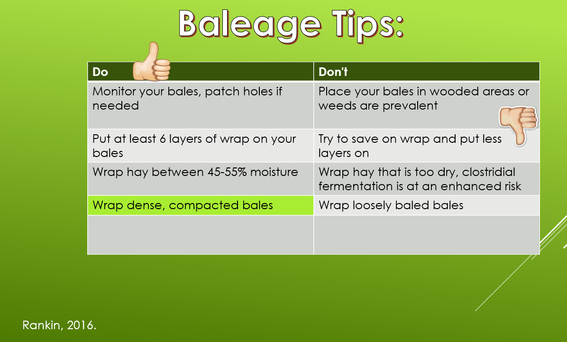|
Hay season is in full swing, so whether you are a first-time wrapper or have been wrapping for years, keep reading for a list of things you can do to make sure you get the best possible silage from your wrapped hay. 1.Wrap dense, compacted bales. For the best results, you want to wrap tight bales so that the plastic wrap fully encompasses the bale with no room for air pockets. Using the right baler is key, as well as using a balewrapper that fully covers the bale in plastic. 2. Wrap hay between 45-60% moisture. If you wrap your hay between this range you will have good silage that will have good feed value for approx. 1 year. This moisture level is needed to achieve optimal fermentation. The ideal time to mow is during the vegetative stage (just before it is all headed for grass, and for legumes when you see about 10% flowers.) Some good tips on which bales to feed first goes like this: Feed First: bales that were wrapped at greater than 60% moisture Feed Second: bales that were wrapped at less than 40% moisture Feed Last: bales that were wrapped between 40-60% moisture 3. Put at least 6 layers of wrap on your bales. We see a lot of people try to save money by using less layers of wrap, but you are really doing yourself a disservice if you do this. In warmer climates, even 8 layers of wrap are recommended. Choosing the right silage film is also important: you should pick a film that -will last one year -is white -provides excellent oxygen barrier that will keep the CO2 inside the bale Below is an easy chart of how to count layers based on rotations of the wrapper. 4. Be mindful of where you place your bales. You should place your wrapped bales on a level surface, away from trash, in a well-drained area. You should wrap uphill whenever possible and plan to wrap within 4-8 hours of cutting. You can store individually wrapped bales on their ends where the plastic is thicker whenever possible. 5. Monitor your bales. Just like you check your crop in the field, checking your wrapped bales is no different. Checking your bales for puncture holes regularly will help- and if you do see a hole, use repair tape to patch the hole. Patch tape for wrapped bales should be easily available at your local dealerships. Resources: Adam, Bernard. 2017. “The How and Why of High Moisture Hay.” Tubeline Mfg. Rankin, Mike. 2016. “Make baleage, not failage.” Hay & Forage Grower. https://hayandforage.com/article-996-make-baleage-not-failage.html Comments are closed.
|




 RSS Feed
RSS Feed